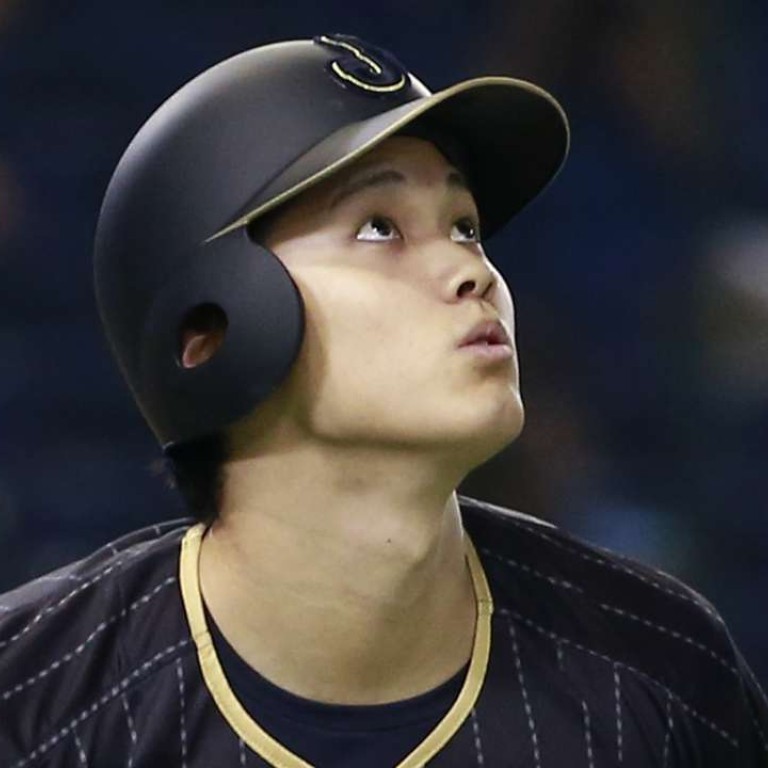
Why a world of riches awaits Shohei Otani, Asia’s most enthralling young sporting star
Japan’s uniquely talented baseball prodigy has big-money major league teams salivating
The most dynamic athlete in Asia is arguably the most dynamic athlete in the world. Go ahead, smirk if you want. But understand that it’s Shohei Otani’s world while the rest of us are merely renting oxygen.
At 22 years of age, the Japanese wunderkind is a strapping phenom who is not only the best pitcher currently not in the major leagues, he is one of the best hitters not in the major leagues.
When asked to find a baseball player blessed with a similar skill-set, insiders could come up with only one name: Babe Ruth, the legendary slugger who was once a star pitcher as well.
When the only relevant comparison is to arguably the greatest player in the long and storied history of the game, you know this kid is beyond special. And things are about to get very, very interesting for Otani on the global stage.

As a teenager growing up four hours north of Tokyo in the small town of Oshu, Otani was so dominating that he wanted to go directly to the US Major Leagues and forgo Japan’s professional circuit. “It’s been my dream since entering high school,” he said.
It may have been Otani’s dream but it was Japan’s nightmare. The country’s most desired player snubbing the domestic league would be a disastrous loss of face and could set a precedent that might eventually doom one of the oldest and most respected professional sporting leagues in Asia.
The New York Yankees, Boston Red Sox and Los Angeles Dodgers, all understandably expressed an interest. However, despite his stated wishes the Hokkaido Nippon Ham Fighters still selected Otani in the 2012 amateur draft in hopes of persuading him otherwise.

Feeling pressure from a number of factions, the youngster eventually relented when the Fighters promised him he could play the outfield on days he was not pitching. “I want to give back to the people that helped me up until this day and to the people from my home town by having them see me pitch in Japan,” he said. Major League Baseball backed off – for now. Fast forward four years and Otani has not only met the hype, he has exceeded it. This season he hit for a .322 average, second in the league, while also slugging 22 home runs, good enough for eighth overall despite having more than two hundred less plate appearances than any other leaders.
And then there are his pitching statistics. Otani had a microscopic earned run average of 1.86 while averaging a league-leading 12 strikeouts every nine innings. He is the first Japanese pitcher to break the mythical 100 miles an hour barrier and now routinely throws pitches in the range of 160km/h.

Last week in a tune-up for next year’s World Baseball Classic (WBC), Otani hit a towering drive through the roof of the Tokyo Dome. It’s clear that Japan can no longer contain his talent and in a few months’ time when the finals of the WBC are contested in the US, he will be the most coveted property on the field.
Baseball is overrun with stupid money right now. Nine players have contracts over US$200 million and one, Giancarlo Stanton, of the Miami Marlins, is over US$300 million. It won’t be long before we see baseball’s first US$400 million man. This past year, Otani made US$1.8 million while the highest paid player in the Japan league was at US$4.9 million. Not exactly impoverished but you do the math.
Otani’s Japanese team would also receive US$20 million from the Major League club that signs him. And the best part is that at 22, he is a good four or five years away from his prime. Japanese pitchers notoriously burn out from over-use, which shouldn’t be an issue with the youthful Otani.
However, if that does occur then simply give him a bat and let him slug his way to riches. It might not happen this coming year, but all indications are that by 2018 he should be the highest-paid Asian athlete ever in a team sport – and not by a little bit either.

